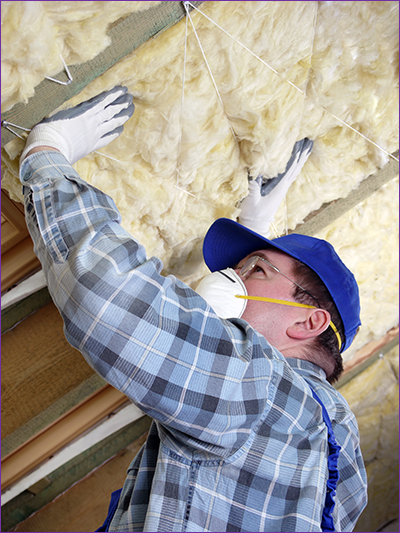Loft and Cavity Wall Insulation
28/02/2020
278
4 min read
Loft and cavity wall insulation: this describes when insulating material is present in the loft and/or cavity wall of a home which lessens heat loss to the outside, thus saving money on heating bills and therefore also reducing the overall carbon footprint.
Various measures taken estimate that when a home is uninsulated, 35% of heat escapes through the walls and 25% through the roof. Loft and cavity wall insulation is generally present in properties built from the 1990s but before that, its presence cannot be assumed.
It is generally accepted that having loft and cavity wall insulation is the most cost-effective way of cutting heating bills if these have not been installed in a home. Cavity wall insulation, however, is not without its controversy: a number of cases reported have claimed that where this is not installed to the highest standards, problems such as damp caused by wicking up moisture from the outside can occur.
If you’re considering buying a new property, getting a home buyers survey will mean that you will have a qualified RICS surveyor to examine the loft, if accessible. They will also be able to form a qualified opinion on cavity wall insulation; whether it has been fitted and whether it would be worthwhile to fit. Additionally if there are any issues, you can bargain for a reduction in price with the vendor or about contributing towards the costs of any required remedy.
Read our guide to loft and cavity wall insulation below.
Queries about insulation? Call our experts on 0333 344 3234
*RICS Surveyors – Local Knowledge – Same Week Availability
Want help now? Call us on 0333 344 3234 (local call charges apply)
Loft and cavity walls - what materials are used to insulate them?
- 1
Loft
- Batt or blanket - either glass, mineral or rock fibre or foil-backed felt. Considered easy to install without requiring a professional and works for easily accessible spaces, (even for insulating exposed cavity walls) . Materials such as glass fibre can serious irritate the skin however so care should be exercised when fitting.
- Loose-fill - granular or lightweight materials used e.g. cork, mineral wool, cellulose fibre, recycled newspaper. Protective clothing and safety equipment is needed to install it and materials can loosen if a loft is particularly draughty.
- Sheet - these are firm and often fire- and moisture resistant. The material is good for insulating the sloping side of a roof. Sheets may be fire- and/or moisture-resistant. This approach is comparatively more expensive than for the materials above.
- Blown-fibre - gaps between joists are filled with fibre insulation blown into the spaces by a professional contractor. The process is quite rapid and is a solution when a loft is difficult to access but it is normally the most expensive material and method.
- 2
Cavity
- Mineral wool/rockwool - cheapest and quickest to install; but its lifespan is apparently less than for other materials.
- Polystyrene Beads - these insulate more effectively than mineral wool does but they are more expensive and great care has to be taken to ensure there are no gaps in them to guard against future damp penetration.
- Foam - either polyurethane or urea formaldehyde. The material can be highly effective but it can take up to 3 days for a professional to install and it normally costs the most out of all the materials. Foam also breaks down over time.

What is the cost of loft and cavity wall insulation?
We found estimates that insulation of cavity walls in a home costs on average between £400 - £500 to install (the price would increase further if foam or beads are used) and similarly that loft insulation costs about £300 (the price would increase if blown fibre is used).
Are there any Government or other schemes which either subsidise fitting insulation or provide free grants?
Yes - there are various schemes where people can get either a subsidy towards the insulation costs or even get it for free.
Click to access Money Saving Expert's Free Insulation and Boilers page online.
You should visit the Government's online Green Deal Energy Saving Measures page and Help to Heat page for various energy grants. Check your eligibility and any scheme's terms and conditions.
If I install insulation, what might I save?
Estimates vary considerably but one prominent and respected organisation stated that an average three-bedroom home could save up to £160 per year if cavity wall insulation is present. Similarly, an average three-bedroom home might save up to £150 per year if loft insulation is present.
Queries about insulation? Call 0333 344 3234 or email help@samconveyancing.co.uk
NB A RICS surveyor only carries out a non-invasive examination i.e. they will not take up floorboards or drill holes. They will look into the loft if there is access and into cavity walls if this can be done without disturbance. However a chartered surveyor can absorb much from a non-invasive visual inspection because of years of experience and training.
*RICS Surveyors – Local Knowledge – Same Week Availability
Want help now? Call us on 0333 344 3234 (local call charges apply)
FREE Online Conveyancing Process For Buyers
Our conveyancing process area includes:
- online checklists
- videos
- free downloads
- useful tips
It is completely free to use - from start to finish - and saves your progress along the way.









